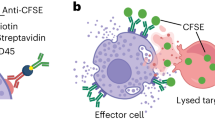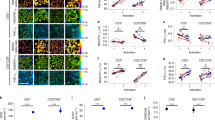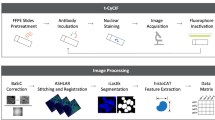Abstract
IMMUNOLOGICAL reactions depend for their completeness on at least two different populations of lymphocytes, one derived from the bone marrow and the other from the thymus (B and T cells). B lymphocytes, precursors of the antibody-forming cells of vertebrates, are recognised in vitro by two characteristic reactions: surface fluorescence with antisera to immunoglobulins1 and rosette formation with red cells sensitised with some components of complement2. Since the cells that show surface immunofluorescence are retained on columns of beads coated with antibodies to immunoglobulins3, surface fluorescence is generally interpreted to mean that immunoglobulins are present on the surface of B lymphocytes4.
This is a preview of subscription content, access via your institution
Access options
Subscribe to this journal
Receive 51 print issues and online access
$199.00 per year
only $3.90 per issue
Buy this article
- Purchase on Springer Link
- Instant access to full article PDF
Prices may be subject to local taxes which are calculated during checkout
Similar content being viewed by others
References
Pernis, B., Forni, L., and Amante, L., J. exp. Med., 132, 1001–1018 (1970).
Bianco, C., Patrick, R., and Nussenzweig, V., J. exp. Med., 132, 702–720 (1970).
Wigzell, H., and Andersson, B., J. exp. Med., 129, 23–36 (1969).
Fröland, S., Natvig, J. B., and Berdal, P., Nature new Biol., 234, 251–252 (1971).
Hämmerling, V., and Rajewsky, K., Eur. J. Immun., 1, 447–452 (1971).
Pernis, B., Chiappino, G., Kelus, A. S., and Gell, P. G. H., J. exp. Med., 122, 853–876 (1965).
Vitetta, E. S., Baur, S., and Uhr, J. W., J. exp. Med., 134, 242–264 (1971).
Marchalonis, J. J., Cone, R. E., and Atwell, J. L., J. exp. Med., 135, 956–971 (1972).
Merler, E., and Silberschmidt, M., Immunology, 22, 821–831 (1972).
Geha, R. S., Schneeberger, E., Rosen, F. S., and Merler, E., J. exp. Med., 138, 1230–1247 (1973).
Geha, R. S., Schneeberger, E., Gatien, J., Rosen, F. S., and Merler, E., New Engl. J. Med., 290, 726–728 (1974).
Hurst, M. M., Niedermeier, W., Zikan, J., and Bennett, J. C., J. Immun., 110, 840–847 (1973).
Putnam, F. W., Florent, G., Paul, C., Shinoda, T., and Shimiza, A., Science, 182, 287–291 (1973).
Axen, R., and Ernback, S., Eur. J. Biochem., 18, 351–360 (1963).
Clark, H. F., and Shephard, C. C., Virology, 20, 642–645 (1963).
Dicke, K. A., Tridente, G., and Van Bekkum, D. W., Transplantation, 8, 422–434 (1969).
Author information
Authors and Affiliations
Rights and permissions
About this article
Cite this article
MERLER, E., GATIEN, J. & DE WILDE, G. Significance of immunofluorescent staining of lymphocytes with antisera to IgM immunoglobulins. Nature 251, 652–654 (1974). https://doi.org/10.1038/251652a0
Received:
Issue Date:
DOI: https://doi.org/10.1038/251652a0
This article is cited by
Comments
By submitting a comment you agree to abide by our Terms and Community Guidelines. If you find something abusive or that does not comply with our terms or guidelines please flag it as inappropriate.



